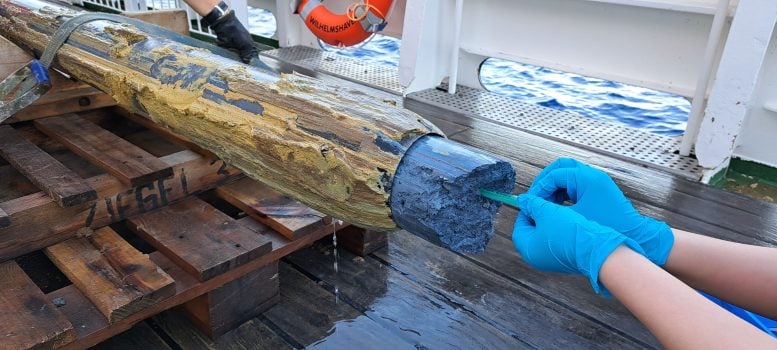níje lí?
This phrase might sound like gibberish to anyone on Earth. But if you ever ran into a gray Ríli humanoid in the fantastical world of Aeniith, those words would come in handy. It means “How are you?” in Rílin, one of the 22 languages invented by Margaret Ransdell-Green. She’s a linguist who makes constructed languages, or conlangs.
Ransdell-Green has been inventing new languages since she was 8 years old. Her first language was called Rhymish because many words rhymed. Along with Rílin (which has over 3,500 words), it’s one of the seven languages spoken in Aeniith. That’s the fictional planet Ransdell-Green has built over the past 20 years, filled with its own people, landscapes and animals. She even sings in those languages!
Creating conlangs was something Ransdell-Green started doing just for herself. But now, it’s her job. Ransdell-Green uses her expertise in the science of language to create all sorts of conlangs for authors, comic book creators and other artists. One of her conlangs was inspired by the calls of goats. Another was inspired by the chemical signals between the root systems of plants and mycelia, the rootlike structures of fungi.
Based in Fairbanks, Alaska, Ransdell-Green is doing exactly what she dreamed of as a kid. “Thirteen-year-old me would be completely jazzed,” she says. “I’m doing the stuff that she was just discovering and loving, and my love has only grown more.”
In this interview, she shares her experiences and advice with Science News Explores. (This interview has been edited for content and readability.)
 This poem is written in Rílin. It reflects the loss and grief felt by the fictional Ríli people during their forced diaspora. M. Ransdell-Green
This poem is written in Rílin. It reflects the loss and grief felt by the fictional Ríli people during their forced diaspora. M. Ransdell-Green
What inspired you to start constructing languages?
At first, making my own languages was just part of my imaginative play as a kid. I would make up stories about people who had their own words for things. I would draw maps of continents, countries, different people and their histories and languages, animals and other features of the world. I did write stories that were set in this world, but they were almost secondary to the creation of the world.
Let’s learn about the science of language
Later, I started learning languages from the real world. I was really interested in William Shakespeare’s works. When I was reading these plays, I noticed a lot of other languages in the dialog. It was the first place I saw Latin. That made me want to learn it. One day at the library, I found a text from the 1950s about learning Welsh. So by chance, I got really interested in Welsh. My mom also speaks French, so I learned French from her.
Everything snowballed from there. I studied linguistics in college and went on to get all sorts of other degrees in linguistics. So constructed languages, real-world languages and linguistics all went together for me from a young age.
What are you thinking about when making a new language?
Language is intrinsically a part of a people’s culture. It’s part of this constellation of things that make up different people.
I imagine who these people are and what they’ve been through. A lot of that shows up in the language, especially when I write their poetry, mythology and literature. What is their experience in this world? What does their language sound like? What does it look like? How is it written?
Poetry especially comes from the people’s soul. For example, there’s a diaspora [migration away from one’s homeland] in the history of the Rílin people. They were pushed out of their home while all kinds of tragic things were happening. So in their poetry, there are themes about traveling across the wilderness. There are different emotions, like regret, about what has happened to them.
What project are you most proud of and why?
I’ve been singing for pretty as much as long as I’ve been doing languages. Many years back, I wrote my first song in a constructed language. Now, my husband and I compose music together and play in a band together. We love doing songs in constructed languages.
We perform with our band around town and at conferences. For one of the Rílin songs, called Phatakap, we’ve even made an audience participation thing, where they sing part of the chorus. At first, I thought it would never go well because people don’t even know what the language is. But people are pretty good sports about it.
A lot of constructed language work, or even linguistics, can be super isolating. But music has allowed me to communicate to more people about what I’m doing. Even if you know nothing about language, you can enjoy a song.
Ransdell-Green wrote this song, “Phatakap Bí Xabhét” (“The Winds are Blowing”), in Rílin and often performs it with her band.Where do you get your best inspiration?
A lot of my ideas come from a synthesis of everything that I’ve seen and heard and know. So, the best way for me to get ideas is to just keep learning about the actual world. Being exposed to as many languages as are out there, and all kinds of music styles, is really important to me.
I just absorb stuff, and it all swims around in my subconscious. Then I come up with an idea, and I’m like, “You know what? I think that was unconsciously inspired by all these things.”
What advice do you have for anyone who’s interested in conlangs?
The first step is just learning about languages. If you can get into at least one other language besides your native language, that’s a great start for many people. In terms of world-building for constructed languages, there are a lot of amazing resources on the internet now. One is The Language Construction Kit.
I’m also the president of the Language Creation Society. We’re a nonprofit organization that supports people doing constructed languages. We have members from all over the world, including some as young as 13.
At the end of the day, constructing languages is a creative thing. There’s no conlanger who’s going to tell you, “This is wrong, period.” It’s all just creative choices that you can make.













 Bengali (Bangladesh) ·
Bengali (Bangladesh) ·  English (United States) ·
English (United States) ·